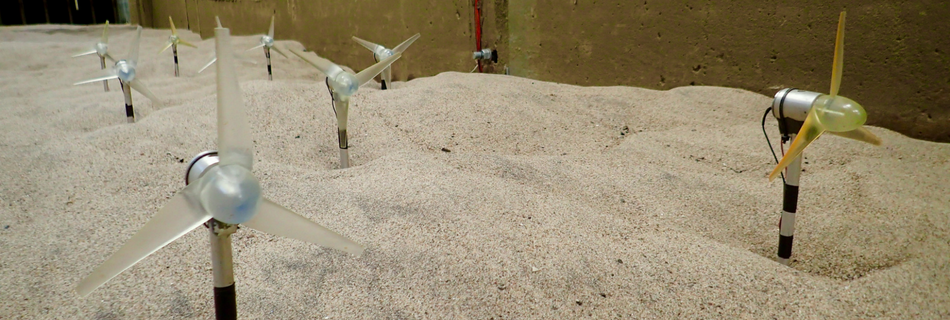University of Minnesota study opens possibility for more environmentally sustainable energy production in rivers

Hydrokinetic turbines are an emerging hydropower technology that takes advantage of moving water currents to generate power. Unlike traditional hydroelectric dams that require larger in-channel infrastructure that can disrupt flow and the river ecosystem, hydrokinetic turbines are placed directly in the river channel and have a much smaller environmental footprint. A new experimental study published in Nature Energy and conducted at the St. Anthony Falls Laboratory (SAFL) at the University of Minnesota suggests that with opportune siting, hydrokinetic turbine arrays can efficiently generate energy with minimal impacts to the shape and behavior of river channels, opening up the possibility for more sustainable energy production in large rivers with active sediment transport.
Hydrokinetic turbine research to this point has mostly focused on coastal environments, specifically, on tidal currents. While there has been much interest in placing hydrokinetic turbine arrays in large rivers like the Mississippi River, very little is known about how these devices affect a river’s form and behavior (morphodynamics) and conversely, how sediment transport and migrating bedforms impact the performance and structural safety of the turbines.
An array of 12 model hydrokinetic turbines were deployed in a quasi-field-scale laboratory channel (85 m long 2.75 m wide) at the St. Anthony Falls Laboratory. All turbines and the channel bathymetry were monitored in space and time to assess the overall submerged power plant performance and its impact on the channel bed. Following results suggest:
- Clustering the hydrokinetic turbine array on one side of the river (in this case 1/5th of the channel cross section) helps minimize disruption of the river’s natural morphodynamics. This siting also makes sense for not only minimizing installation and maintenance costs, but also to preserve other potential uses of the river, e.g. for navigation.
- The siting of hydrokinetic turbines within the array was arranged in a staggered configuration similarly to that of wind turbines, with resulting spatial distribution of generated power mimicking that of wind farms, despite the introduced complexity of active sediment transport and migrating bedforms in the channel.
- When large bedforms such as dunes migrate through the turbine array, as long as the rotors of the turbines are continuously operating, the turbines effectively erode and distort the approaching dune fronts, preventing burial of the turbine blades and damage to the rotors. This ‘self-defense’ mechanism ensures continual energy generation and demonstrates that these arrays are resilient through flooding events under very intense sediment transport conditions.
“This is the most complete study out there that really assesses the impacts of hydrokinetic turbine deployments in rivers,” says primary author Mirko Musa, a SAFL PhD student in the Department of Civil, Environmental, and Geo- Engineering at the University of Minnesota. “What’s really exciting to me is that this technology may be a good alternative for local production of clean energy that can power even remote areas in developed and under-developed countries, with a smaller environmental impact on the river ecosystem.”
“Studies like this one help support the expansion of hydrokinetic energy from the ocean coast to the river network," continues corresponding author Michele Guala, Musa’s primary graduate advisor, SAFL Associate Director of Research, and Associate Professor in the Department of Civil, Environmental, and Geo- Engineering. “As we as a society continue to support diversification of our energy portfolio, this type of hydropower may even present some advantages with respect to solar and wind. Unlike the sun or wind, hydrokinetic turbines will generate energy continuously because the river never sets or dies down – it just keeps running.”
Funding was provided by the National Science Foundation CAREER: Geophysical Flow Control (award ID 13513013) and partially by the Institute on the Environment (IonE), University of Minnesota. Contributions were also made by investigators from Stony Brook University and the University of Washington.
